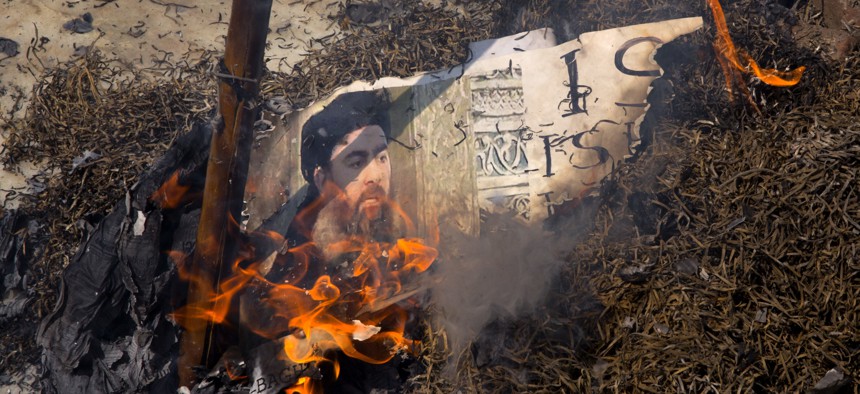
Shiite Muslims burn an effigy of the leader of the Islamic State group, Abu Bakr al-Baghdadi during a protest in New Delhi, India, Friday, June 9, 2017. ap photo/manish swarup
The ‘Caliphate’ Is Gone. Where’s the ‘Caliph’?
As the war on the Islamic State moves into a new phase, its leadership tries to adapt.
As the last shred of Islamic State territory in Syria fell to Kurdish-backed forces this month, thousands of people, including fighters, fled the enclave or surrendered. Yet when the exodus was over and the “caliphate” was extinguished, a mystery lingered: Where was the “caliph”?
“We don’t know where he is,” James Jeffrey, the U.S. special envoy to the global coalition to defeat ISIS, told reporters on Monday. Asked whether finding him was a priority, Jeffrey responded: “Finding the top leadership of ISIS or other terrorist groups is always a priority.”
In the four and a half years since Abu Bakr al-Baghdadi indulged in a rare public appearance, in Mosul, to declare a caliphate—the last part of that period spent with a $25 million U.S. bounty on his head—the titular chief of the Islamic State has eluded capture. He has more than once been rumored dead or incapacitated, only to be reported at large later. A voice that experts believed to be his appeared on a recording last summer, urging followers to wage attacks independently, and he hasn’t been heard from publicly since.
So does getting Baghdadi matter? A spokesman for the U.S.-led coalition to defeat ISIS said two years ago that Baghdadi had been “irrelevant for a long time,” as the Associated Press pointed out. A coalition spokesman wrote to me in an email this week, “What's important to note is that his presence or absence within Daesh [ISIS] has no bearing on their current status.”
The U.S. spent nearly a decade hunting for the al-Qaeda leader Osama bin Laden. A U.S. Navy SEAL team killed him in the spring of 2011, and President Barack Obama declared that his death marked “the most significant achievement to date in our nation’s efforts to defeat al-Qaeda.“ Even so, he said: “There’s no doubt that al-Qaeda will continue to pursue attacks against us.” The experience teaches that Baghdadi’s apprehension could take a while—and that his group can survive it.
Historically, four main factors have helped determine whether and when removing a leader—referred to as “decapitation”—has worked to end a group, explains Audrey Kurth Cronin, the author of How Terrorism Ends. “They’ve been hierarchically structured. They’ve been characterized by a personality. They’ve been on average younger than other groups. And they’ve lacked a viable successor,” she told me. The approach largely worked, for example, in the cases of Peru’s Shining Path, Japan’s Aum Shinrikyo, and Italy’s Red Brigades. “There are lots of cases where groups did end with the decapitation of a leader, but at least in the broad historical picture, it happens more often when you’re able to capture a leader and then undermine his legitimacy—very, very difficult when it comes to Islamist groups, because the question of where exactly to put someone in prison is extremely vexed.”
Al-Qaeda, ISIS, and affiliated groups have proved more complicated.
In bin Laden’s case, “he was always on the radar, always part of the effort” against al-Qaeda, Nada Bakos, a former CIA analyst involved in tracking bin Laden, told me. Documents recovered from his compound following his death show that, even in hiding, he continued to give direction and advice to the group. By the time he died, however, the group had evolved and spread to numerous countries, and it proved resilient after that symbolic blow.
So resilient, in fact, that its leadership in Iraq—which had declared allegiance to bin Laden in 2004 but always charted somewhat of an independent path—laid the foundation for what would become ISIS. Al-Qaeda in Iraq survived the death of its own leader, Abu Musab al-Zarqawi, in 2006, ultimately morphing and reconstituting itself years later as the Islamic State of Iraq and Syria, under Baghdadi’s leadership.
During the Obama administration, the U.S. pursued a strategy of targeting operational ranks of ISIS leadership while it pursued Baghdadi himself. In January 2018, the Iraqi counterterrorism analyst Hisham al-Hashimi told The Guardian that Baghdadi was the last of the group’s 43 main leaders still standing, and that mid-level commanders had to keep changing positions as their cohorts kept getting killed.
That effort itself has likely limited Baghdadi’s effectiveness as a leader. Staying underground, scampering between safe houses, and avoiding the use of communications equipment makes it difficult to organize and inspire. In a group notorious for its exploitation of modern communication methods, Baghdadi reportedly has had limited access to them, for fear of giving his location away, and reportedly nearly did so several times. Yet one of the Islamic State’s key attributes has been its commitment to “leaderless jihad”—in essence, the tactic of allowing loosely connected followers to wage attacks independently of one another. Adherents could, and did, wage attacks in Baghdadi’s name without ever hearing much of what he had to say.
ISIS never pulled off anything even close to the scale of the 9/11 attacks, masterminded by bin Laden, on U.S. soil. That trauma has completely reshaped how America behaves in the world. Despite serious violence in the United States and especially Europe, either inspired by or directed by ISIS, the group has inflicted most of its carnage and horror in Iraq and Syria. The revenge- and justice-driven rationale for finding and punishing Baghdadi in particular is not as strong as it was in the bin Laden case.
That doesn’t mean finding Baghdadi isn’t worthwhile, just that it shouldn’t necessarily be the top priority of the fight that follows the fall of the caliphate. Indeed, U.S. officials have indicated that finding him is just one of many priorities. And as Bakos pointed out, the public doesn’t really have a good sense of what role he plays; consequently, it also doesn’t really have a good sense of what would happen to ISIS after his death. But Bakos cautioned: “These organizations learn how to function, and it’s not always in public view … [Baghdadi] still has a vision and a strategy, and he’s pushing that covertly. That’s a big deal.”
Capturing or killing Baghdadi could prove counterproductive in the long run—for instance, if he is subject to a revenge killing that looks illegitimate to a large number of his followers, or if his death itself enhances his prestige as a martyr. A pure revenge killing may just spur revenge-seeking on the other side. “I’m not saying that just capturing the leader is going to be the answer—it’s capturing the leader and ensuring that the rule of law and the basic institutions of governance prevail,” Kurth Cronin said.
Regardless, said Bakos: “You don’t focus just on one person who’s popular, and the symbolic head [of a terrorist group]. From the perspective of Baghdadi now, the bigger question is: Who’s calling the shots from an operations perspective? If it’s him, then he’s worth resources. If it’s not, then you focus where you need to.” U.S. officials acknowledge this, despite the declaration of the end of the caliphate, and the policy to withdraw most U.S. troops from Syria. James Rawlinson, a coalition spokesman, wrote in an email that ISIS is “actively transitioning to a [resurgent] network of sleeper cells in order to continue to aspire to a caliphate and threaten civilians throughout the region and the world.”
